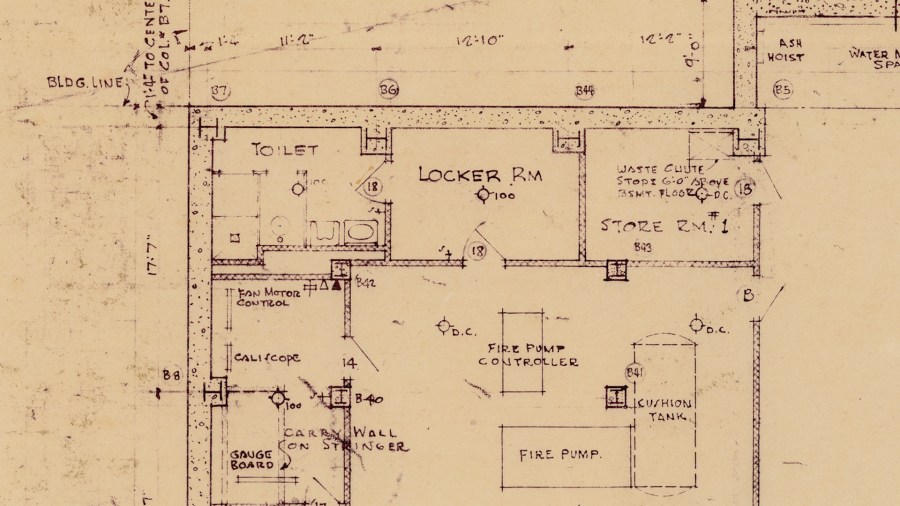CHICAGO — A Chicago-based antique map dealer has recently come into possession of the original architectural plans for the old Chicago Stadium.
At the time, the stadium was the largest indoor arena in the world, but that description only scratches the surface of its significance, according to Sammy Berk, a purveyor of antique maps and prints at the appointment-only shop New World Cartographic.
“A lot of times, plans like these, when they’re not really in use anymore, especially after the building’s been demolished, they sometimes just kind of disappear,” Berk said.
One of Berk’s customers, whose name was not disclosed, discovered the blueprints tucked inside a flat file cabinet at an estate sale. Berk bought them and had them linen-backed to ensure their preservation.
One print shows a cross-section of the stadium. “We essentially have two cross-sectional views,” Berk said. “But this one here, I absolutely love because of the amount of detail that’s in there. And when you look at it, you really kind of get a sense of what it looked like inside the stadium.”
The prints are pieces of artwork that convey scientific knowledge – math and measurements. “It goes into so much detail, down to even just the door studs, and the width of wooden planks, and in some cases, you can see hand annotations that the builders and the architects were using in the design,” he said.
The stadium was built to host a variety of events like circuses, ice shows, rodeos, political conventions, concerts, boxing matches and more.
“Looking into it, I was amazed,” Berk said. “There were circuses. There were six-day cycling races which were really popular. There were ice capades that were going on, and actually, at one point, the Chicago Bears played the Portsmouth Spartans, which are now the Detroit Lions, for the NFL championship in the Chicago Stadium. It also had the famous Barton pipe organ, which had 3,600 pipes.”
It earned the nickname “the Madhouse on Madison,” but because there were no VIP sections, it could’ve been known as “the Melting Pot on Madison.”
“It was one of the few places in America you could go and have mass numbers of white and Black – in this case – Chicagoans come together under one roof for a common sporting event,” Berk said. “It was all in the plan.”
The stadium was a blend of neoclassical and art deco architecture, designed by the firm Hall, Lawrence & Ratcliffe, which also designed the Cook County Courthouse at West 26th Street and South California Avenue.
“A lot of the architects and the people that were involved in the planning and building of this were also involved with the 1893 Columbian Exposition, which was dubbed the ‘White City’ as it was made to look like ancient Greece or ancient Rome,” Berk said.
Colorful Chicago sports promoter Paddy Harmon had the stadium built for $6 million. Construction lasted less than a year. When it opened in March of 1929, it was the world’s largest indoor stadium with a capacity of 26,000 (if the floor seats were used).
“It also had just this beautiful design with these tall windows, above you have the letter ‘H’, which is for Paddy Harmon, the original owner of the Stadium and really the man who was behind the financing and the building of the stadium,” Berk said.
The exterior limestone reliefs reflected classical heroes with modern touches – the drafted details came to life on the side of the building.
“They have these sorts of Olympians paying homage to the ancient Greeks and Romans, yet you have a pair of skates and a pair of boxing gloves, a bicycle set in there, it’s kind of a blend of the Olympians of old with the sports that were popular in the late 1920s,” Berk explained.
The stadium was also the venue for countless Chicago sports memories memories for millions, including the 1966 hockey milestone when Bobby Hull became the first player to score more than 50 goals in a season.
It was also the scene of countless Michael Jordan’s memories, including the “shrug,” after hitting six three-pointers in the first half of a game during in the 1992 Finals, and his iconic free throw line dunk in the 1988 NBA Slam Dunk Contest.
The Chicago Stadium was demolished in 1994 and replaced by the United Center. But this discovery of the original blueprints is an occasion to reflect on the plans and the maps that have guided us for centuries, providing a portal to the past and a framework for the future.
“We find these things, these historical items, people come to us with them, sometimes we restore them, and we find them new homes to collectors or institutions to preserve them for years and generations to come,” Berk said.





